London was crowned the eighth most expensive city on the planet last year, according to Mercer’s 2024 Cost of Living Index. Still, even in the heart of this priciest place to live or visit, it is possible to find spots of amusement, and also culture, that cost nothing at all.
People-watching on Trafalgar Square, for example, could be considered one of the city’s greatest free attractions. From morning until well into the night, the square is alive with activity. Just steps away, you have the National Gallery and the National Portrait Gallery. While nearby luxury shops and fine dining cater to the affluent, these galleries make art accessible to all.
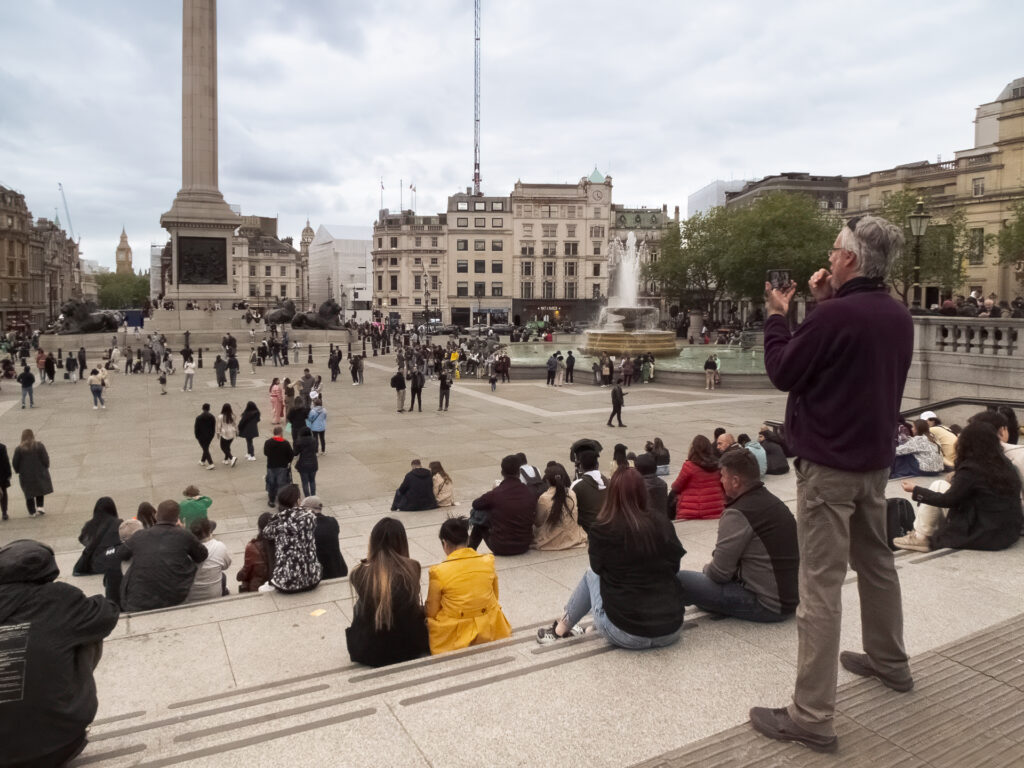
Just like any metropolis, however, London is a city of contrasts. Beneath the privilege of the free access to culture, there are many rough edges. Right next to Trafalgar Square, a soup kitchen operates around the corner from the St Martin-in-the-Fields Church. And many of the workers who keep this part of London running (baristas, shop assistants, and cleaners) often struggle to make ends meet, with many not even receiving paid lunch breaks.
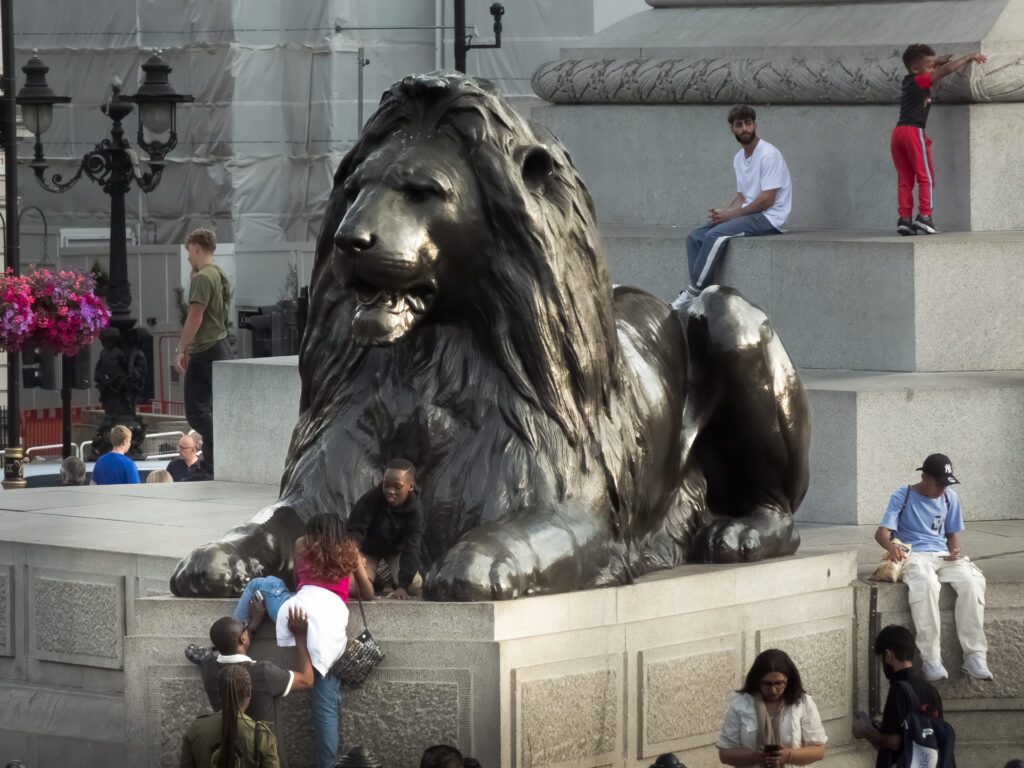
Free Attractions in the heart of the city
Trafalgar Square now feels more like an open-air living room, a place where public and private behaviour blur to some degree. Many people ignore do not climb signs as if they were mere suggestions, climbing the bronze lions regardless. Some may just as easily take a plunge in the fountains.
People-Watching and the New Rules of City Etiquette (or Lack Thereof?)
When people step away from the familiar gaze of home (whether that means family, hometown, or country) they seem to loosen up, as if the usual rules do not quite apply, at least not this time. One might wonder whether this carefree attitude is simply harmless fun, a little inelegant but nothing more, or if it signals a deeper shift in how people engage with public spaces in 2025 and beyond.
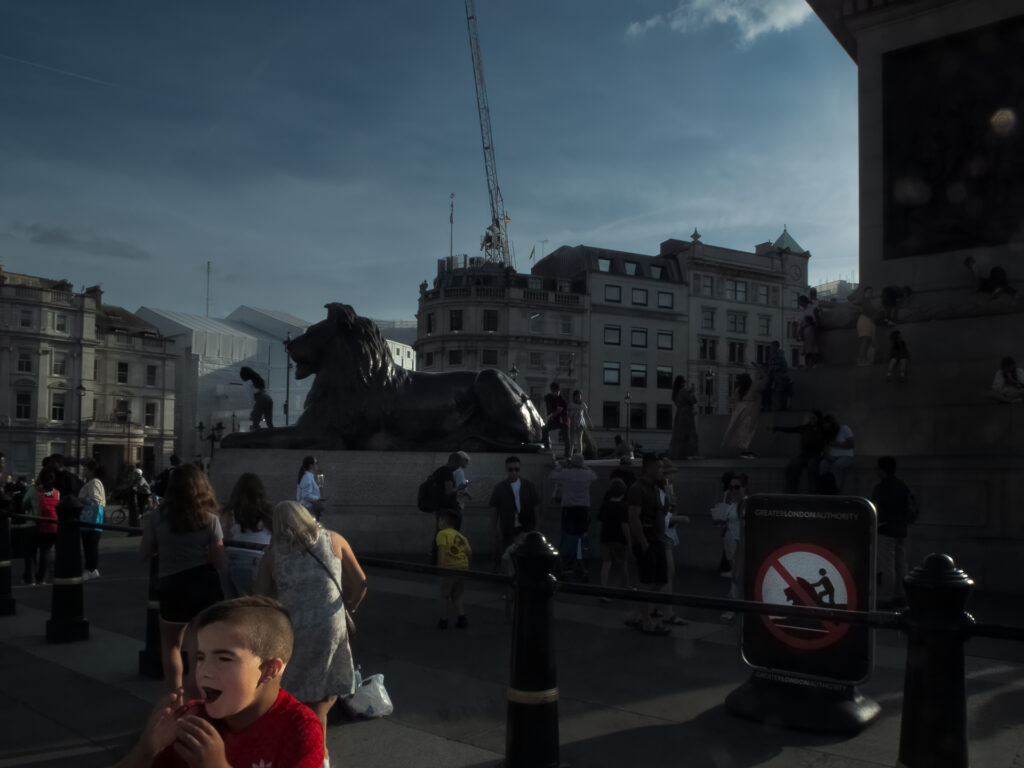
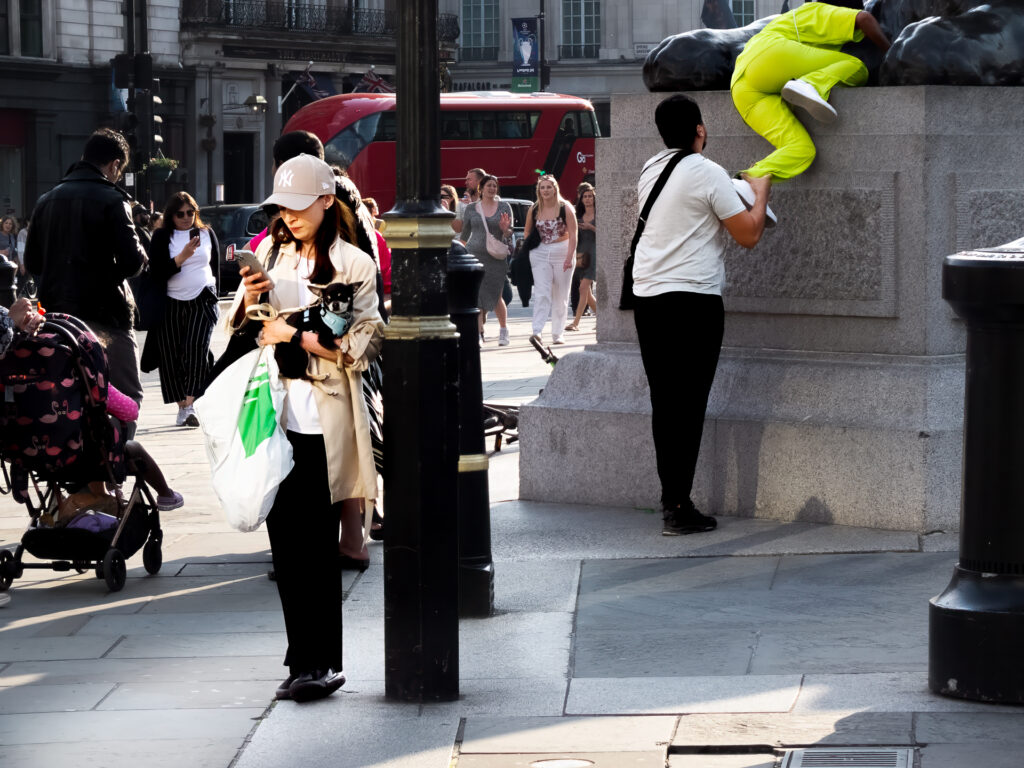
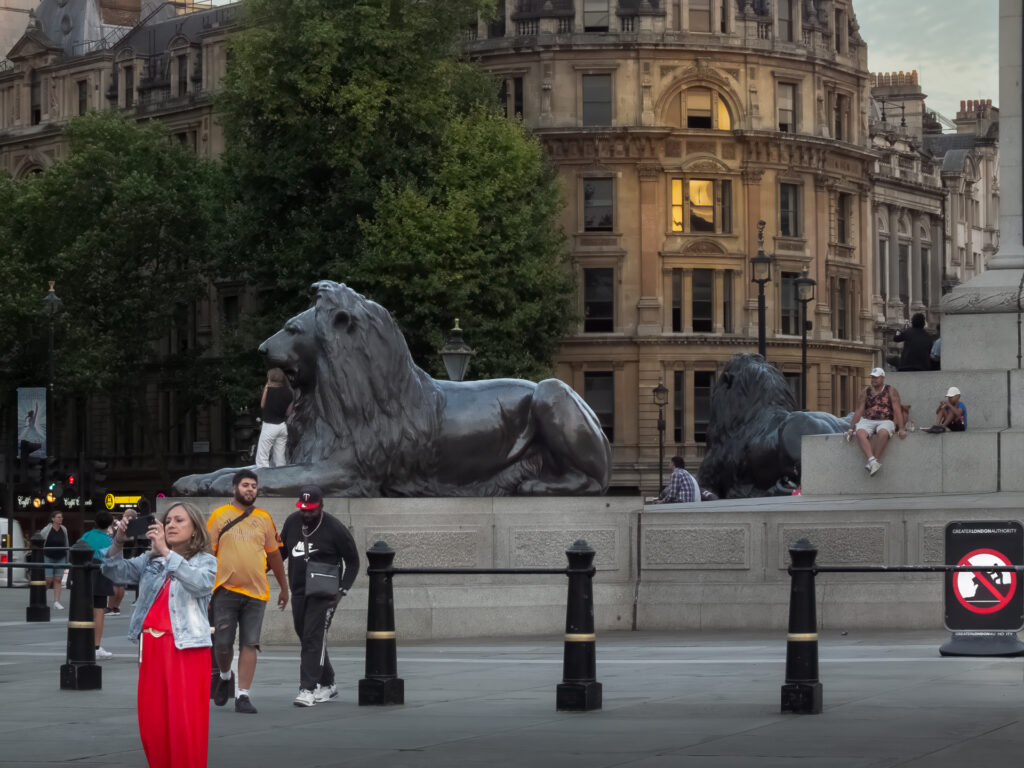
The street theatre of Trafalgar Square: no tickets required.
Trafalgar Square is never just one thing. It is a stage. The people moving through it, locals, tourists, passers-by, are each engaged in their own moments of spontaneity. Some are lost in thought. Others watch the crowd. Some share an experience with others.
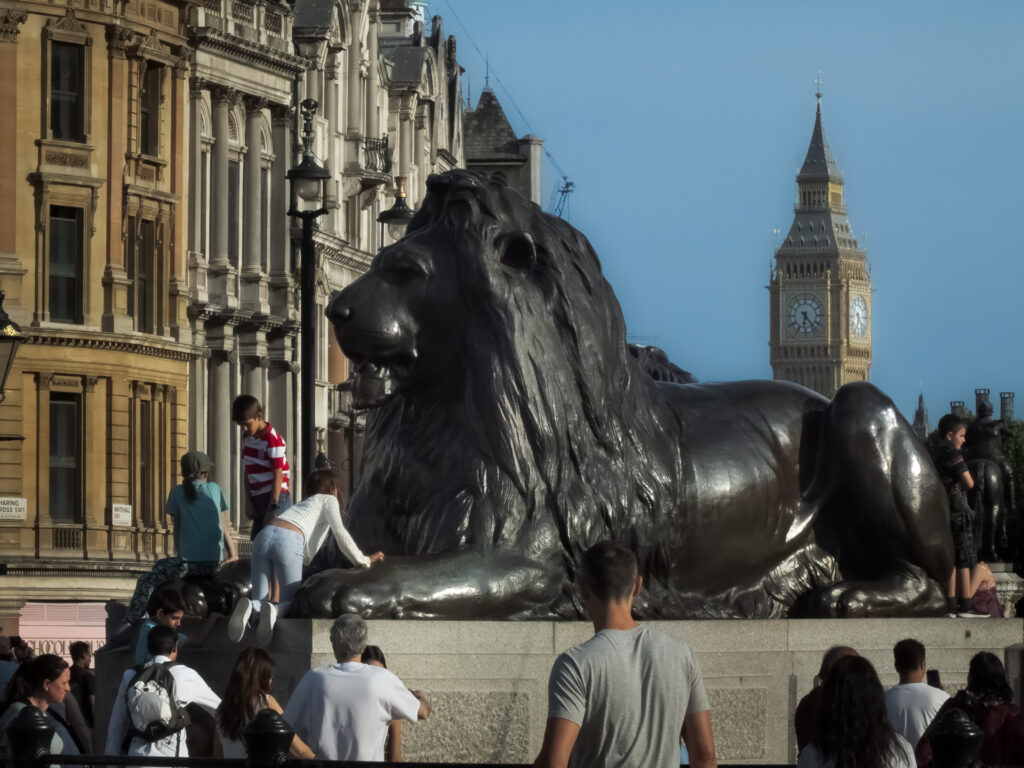
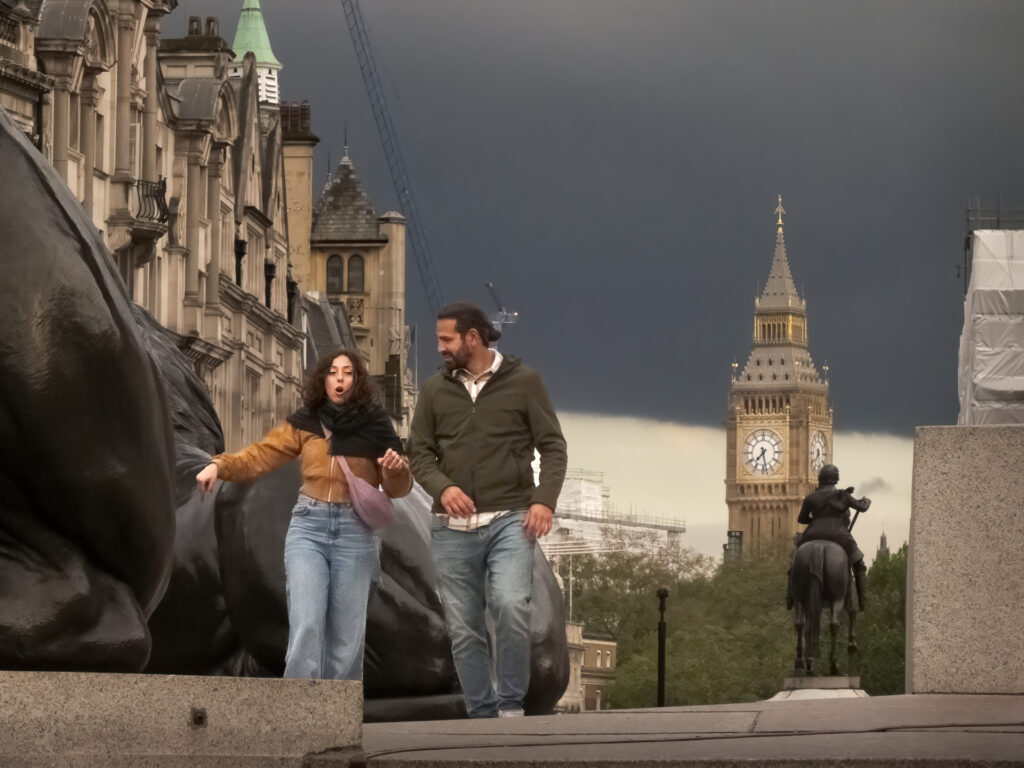
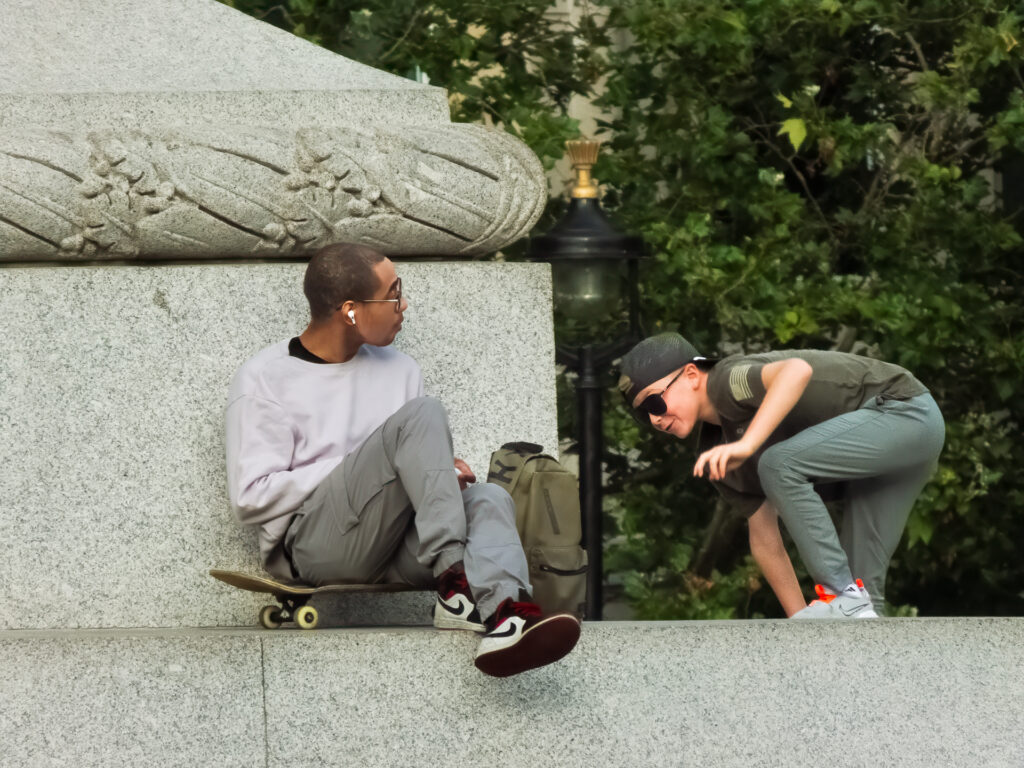
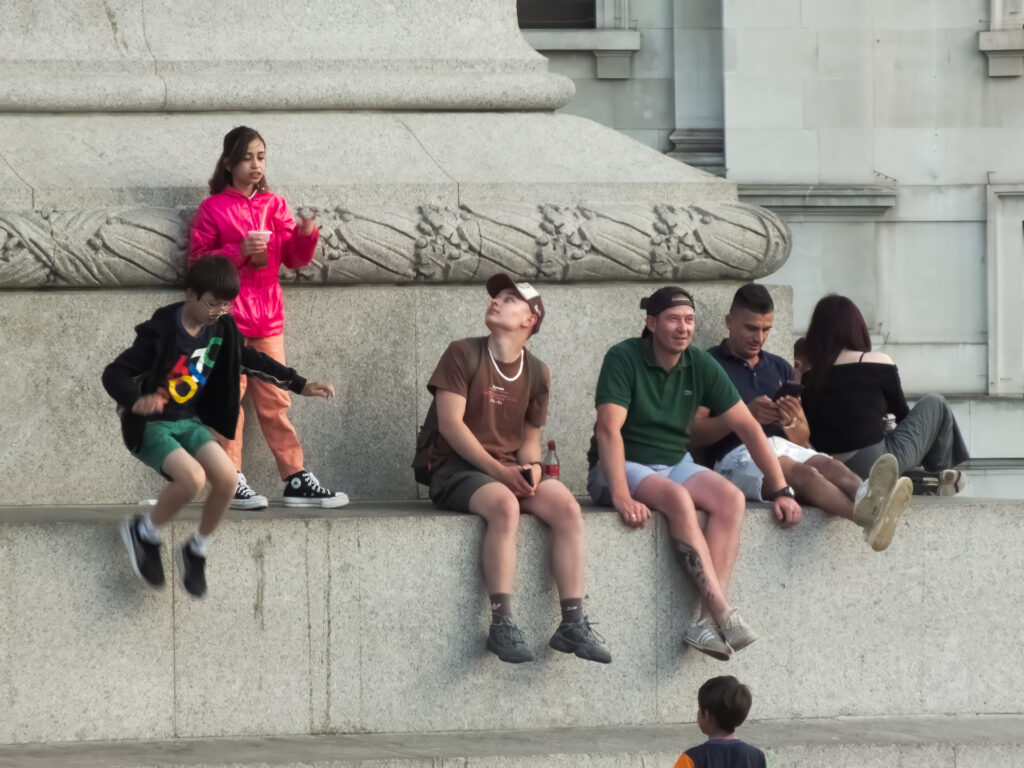
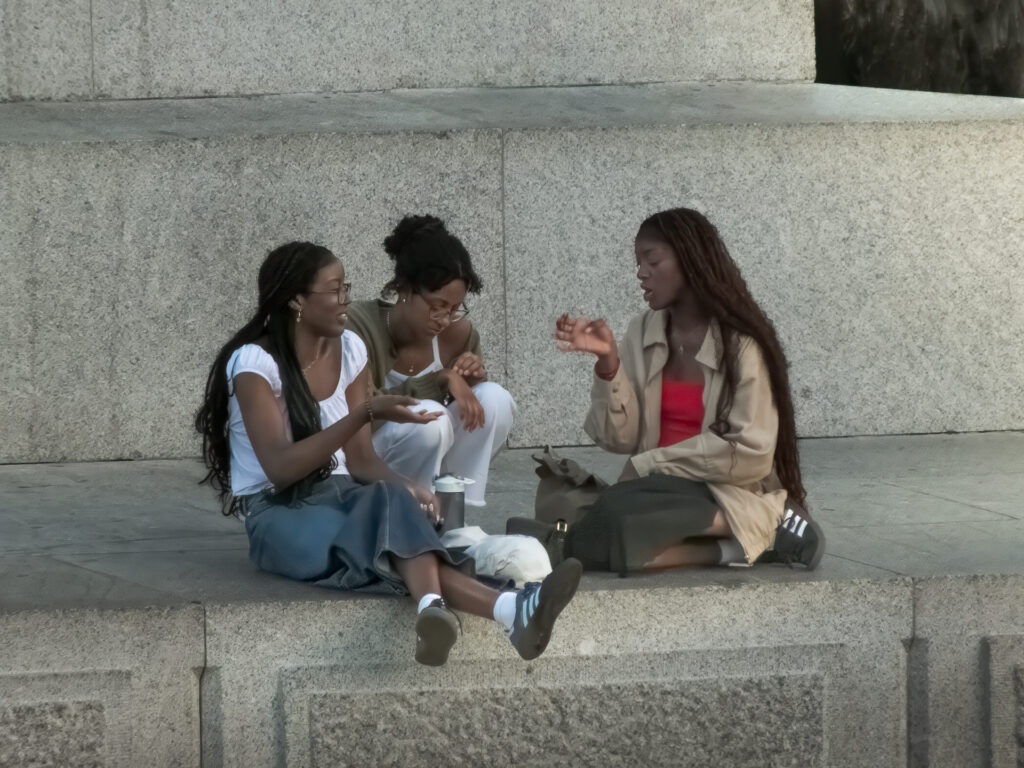
In observing others, we observe ourselves. The figures we notice also say something about us. We are drawn to certain scenes for reasons we do not always realise. We choose to capture what reflects our own interests and assumptions. And what is it that we overlook?
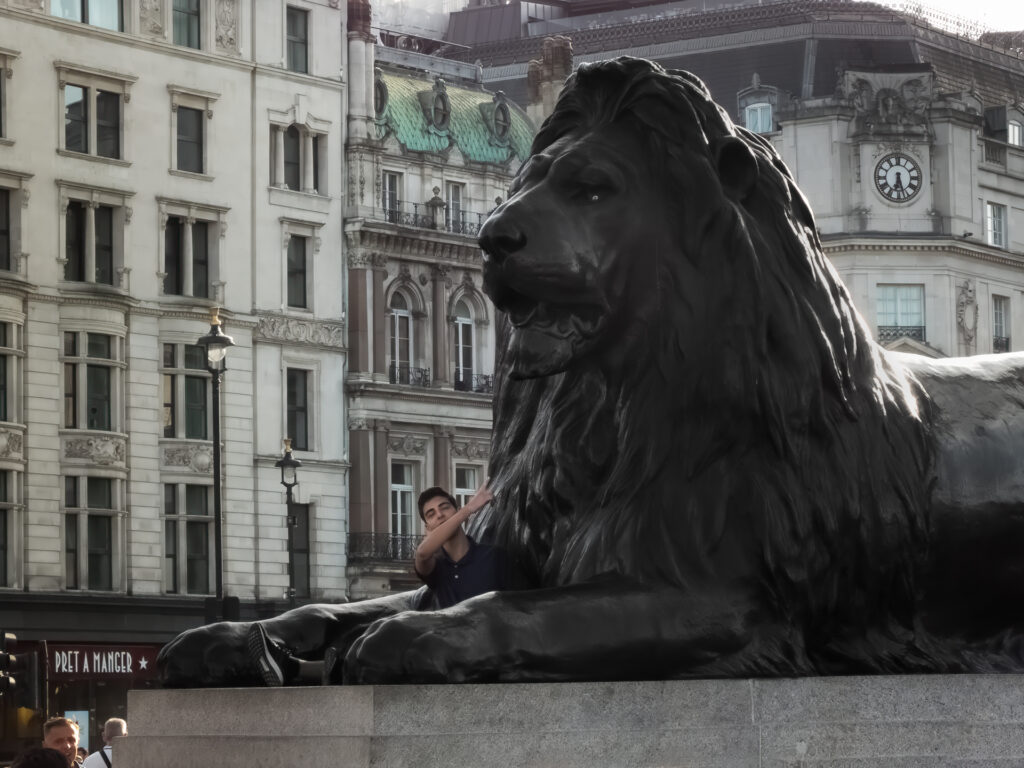
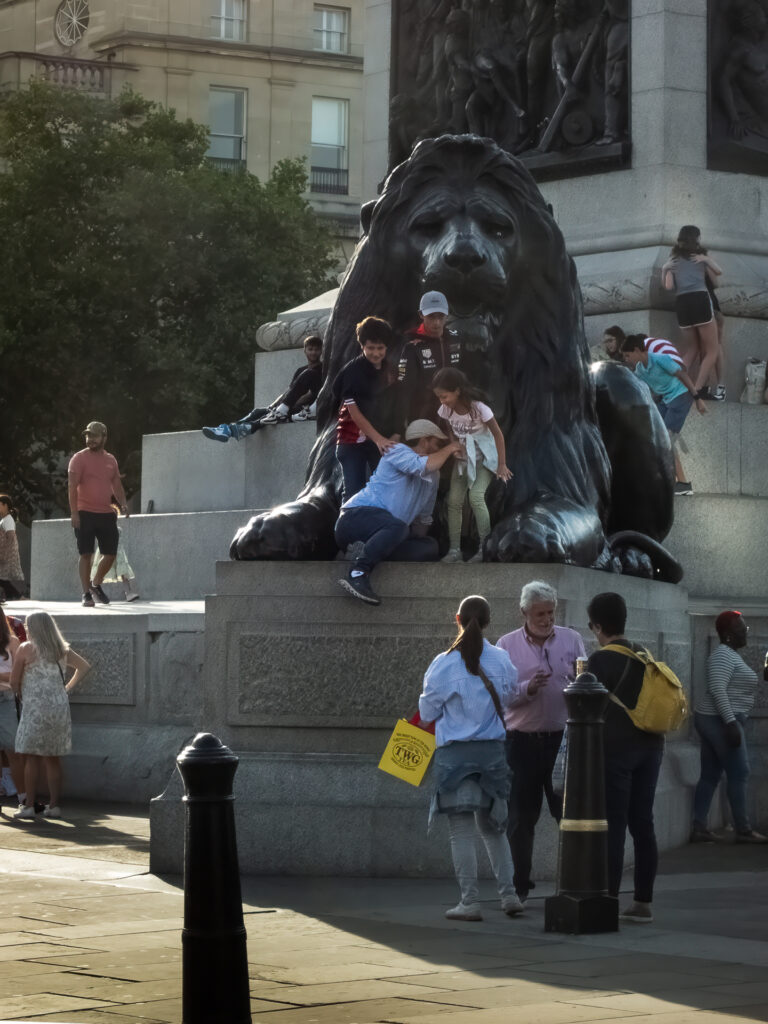
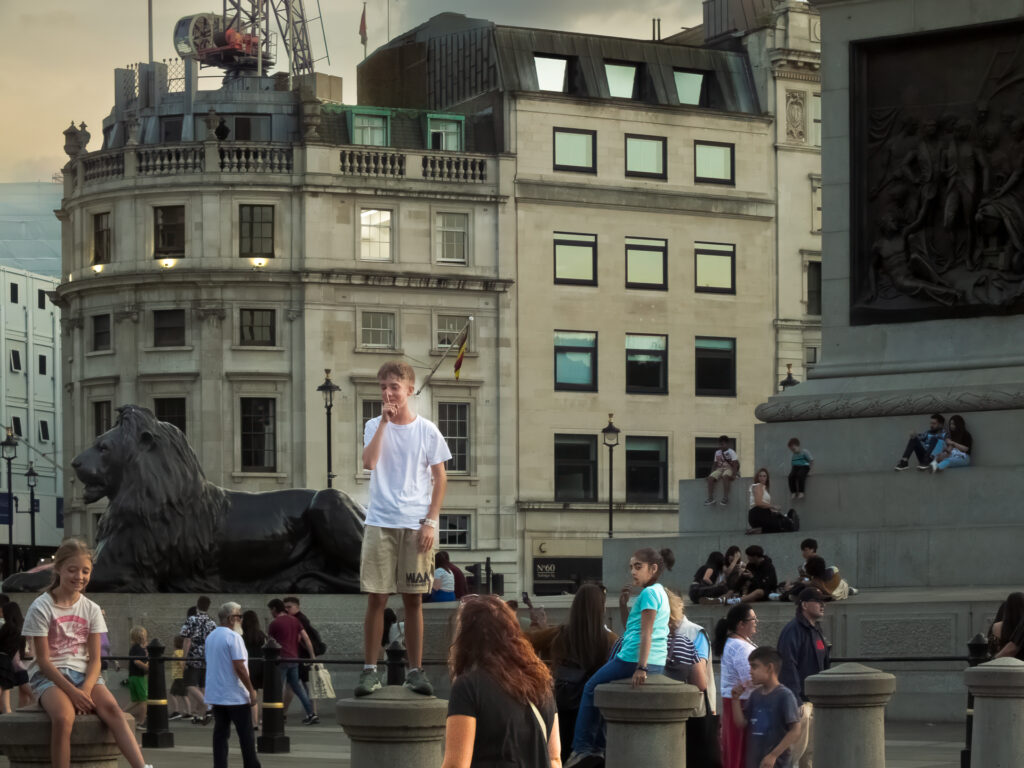
Adventurous
A young woman poses on one of the great bronze lions, obviously ignoring the warnings. She grins down, perhaps revelling in her “I was here” moment. She enjoys the spotlight, but maybe also the thrill of stepping beyond what is allowed.
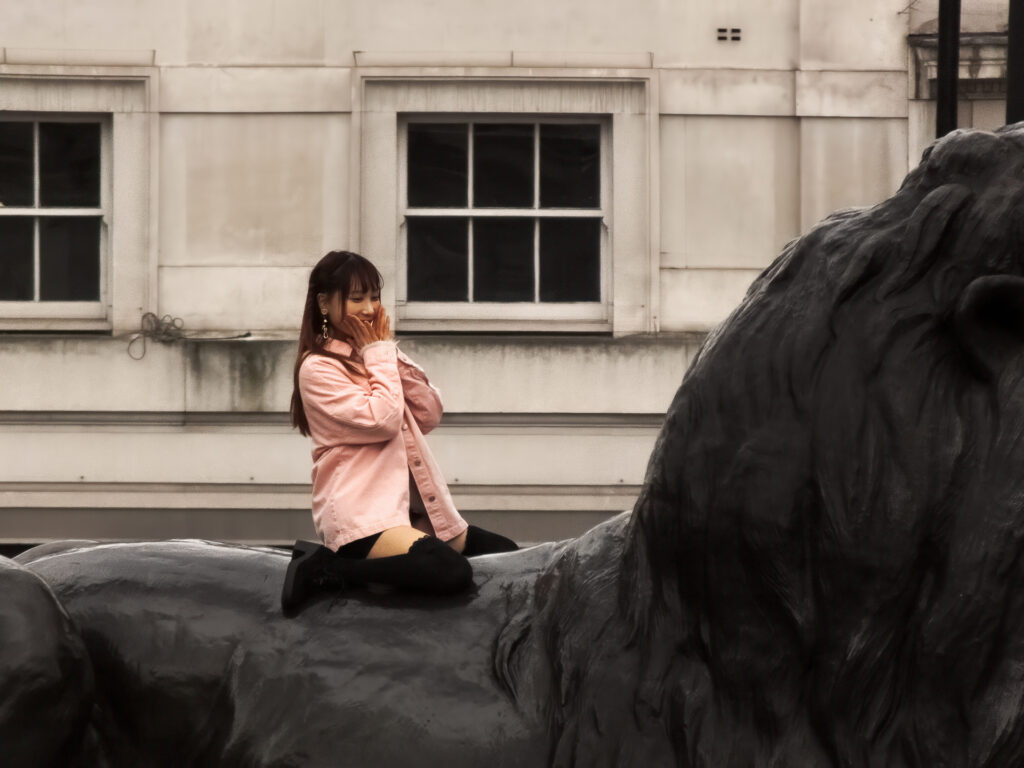
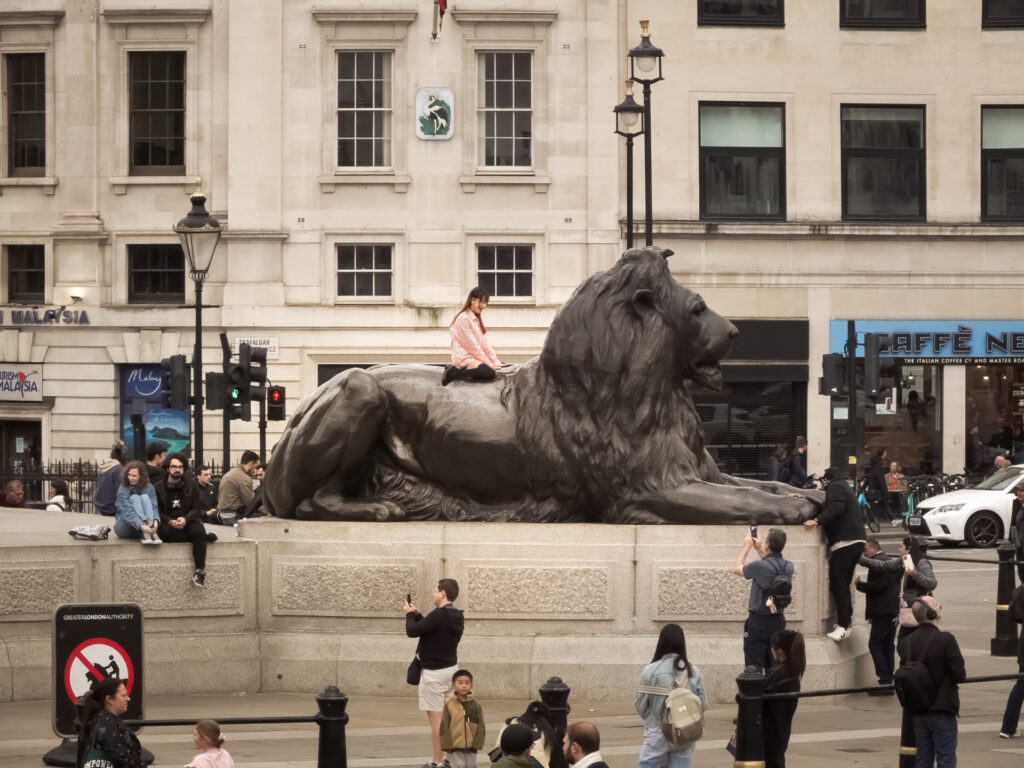
Observant
A woman stands on the steps leading to the National Gallery, phone in hand. She seems to be photographing or video-ing, but the way she holds the phone, horizontally rather than vertically, suggests she is not in a video call. She is neither a participant nor a mere passer-by. She is collecting moments.

Carefree
A young man leaps into a fountain, gliding for a few moments beneath the cascading jets. As he prepares to climb out, water trailing behind him, he seems unburdened by judgment or consequence. There is, perhaps, defiance here. There is also the element of the showman. He performs for an audience, whether they welcome it or not.
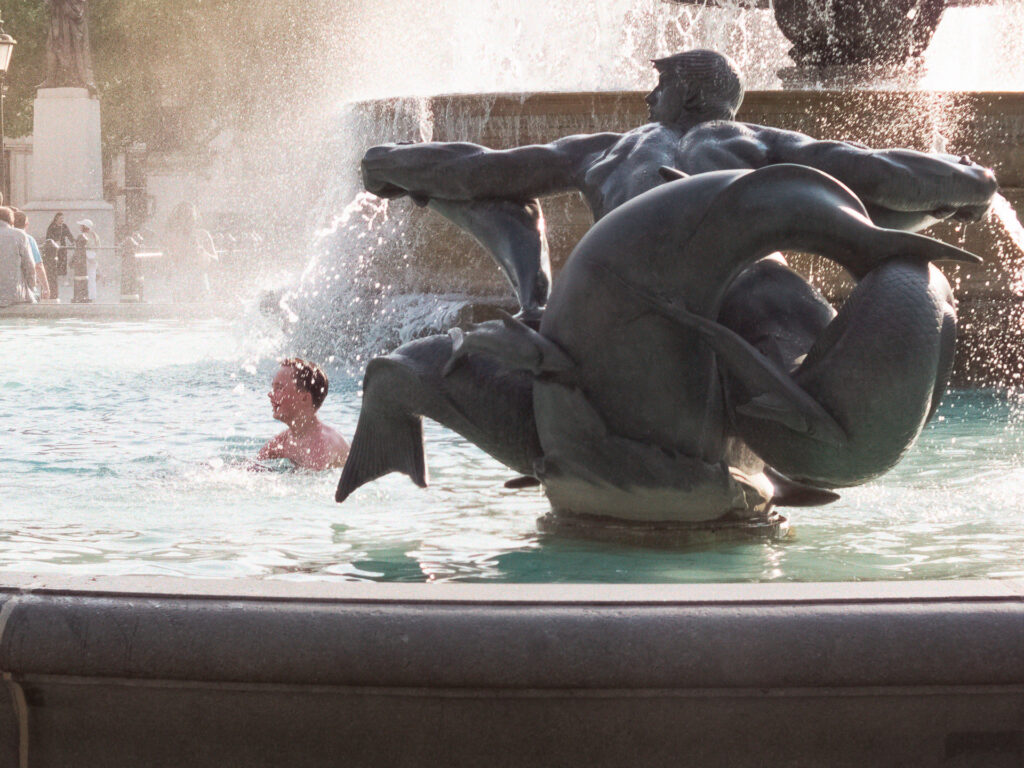
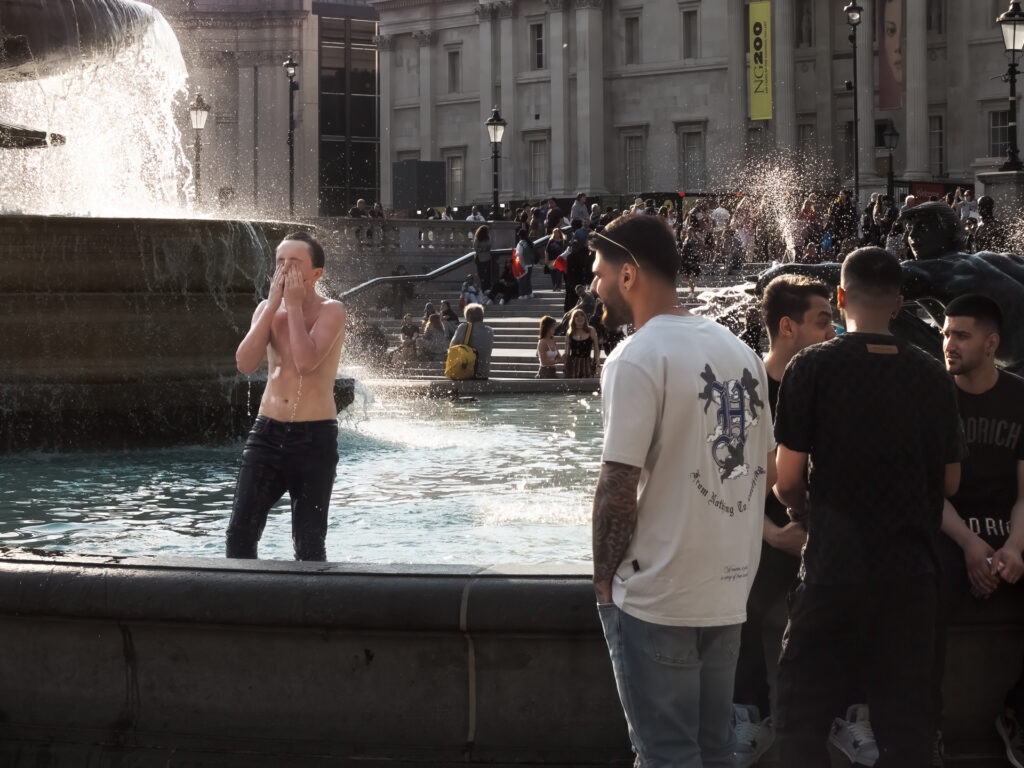
Conversations
A conversation unfolds. The woman has made a remark that seems to startle the man in front of her. Security guards appear in the frame, their presence compressed by the long lens.
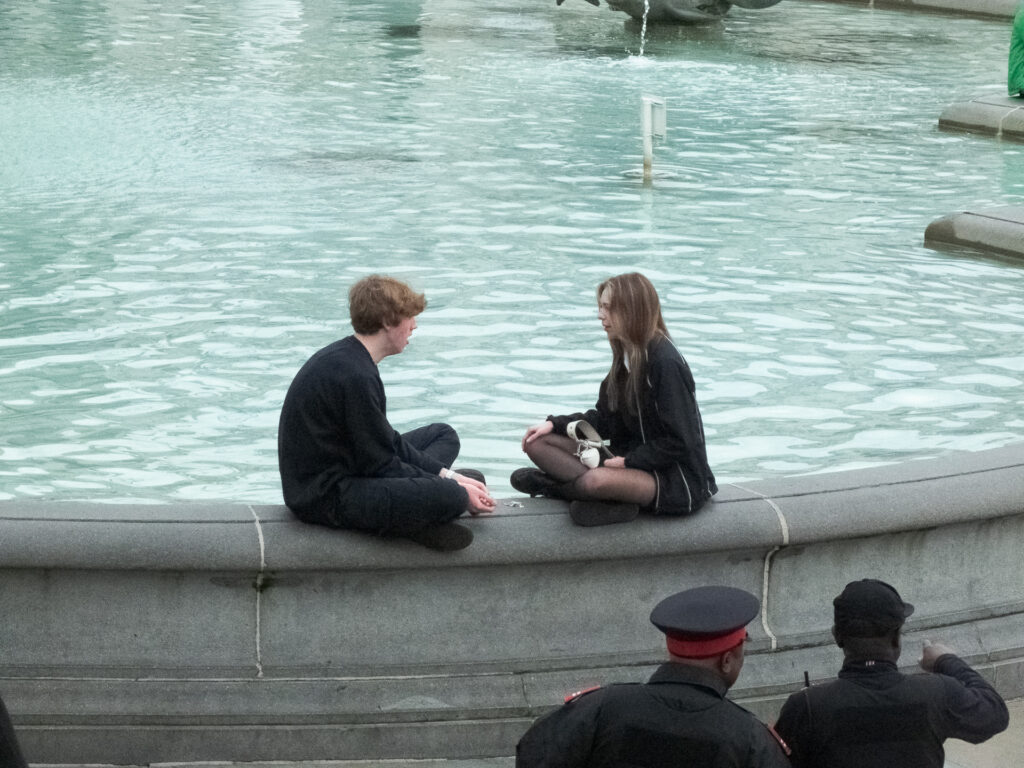
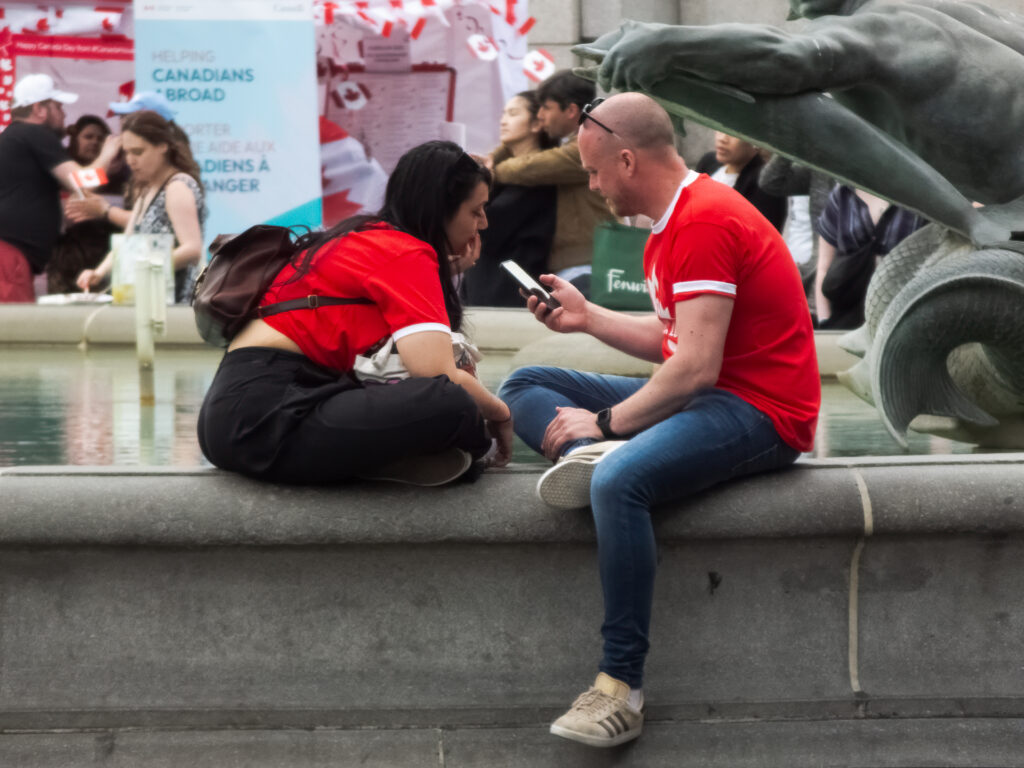
A long way away, on the plinth of the Nelson column, two people are sitting next to each other. One tilts a phone at an angle, as if showing something.
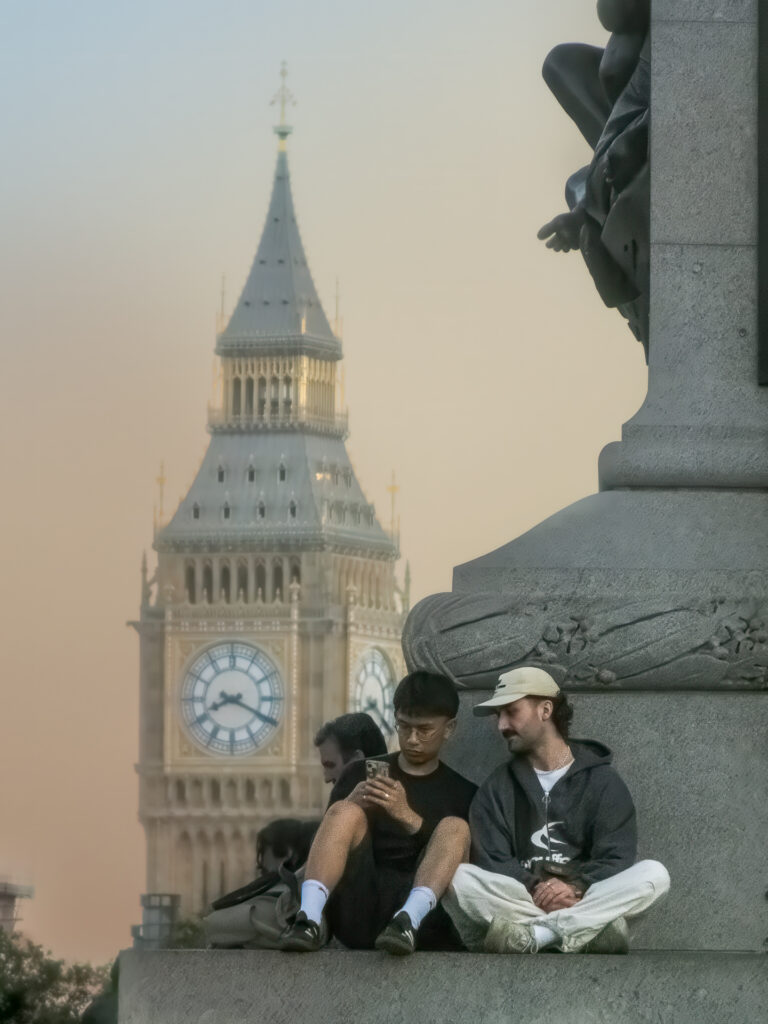
Devotion
Near the steps, a man wears an English flag like a cape, absorbed in his support for the national football team. The team itself will never know he is here. Perhaps he hopes to find fellow fans, to chant with them, to be part of a tribe.
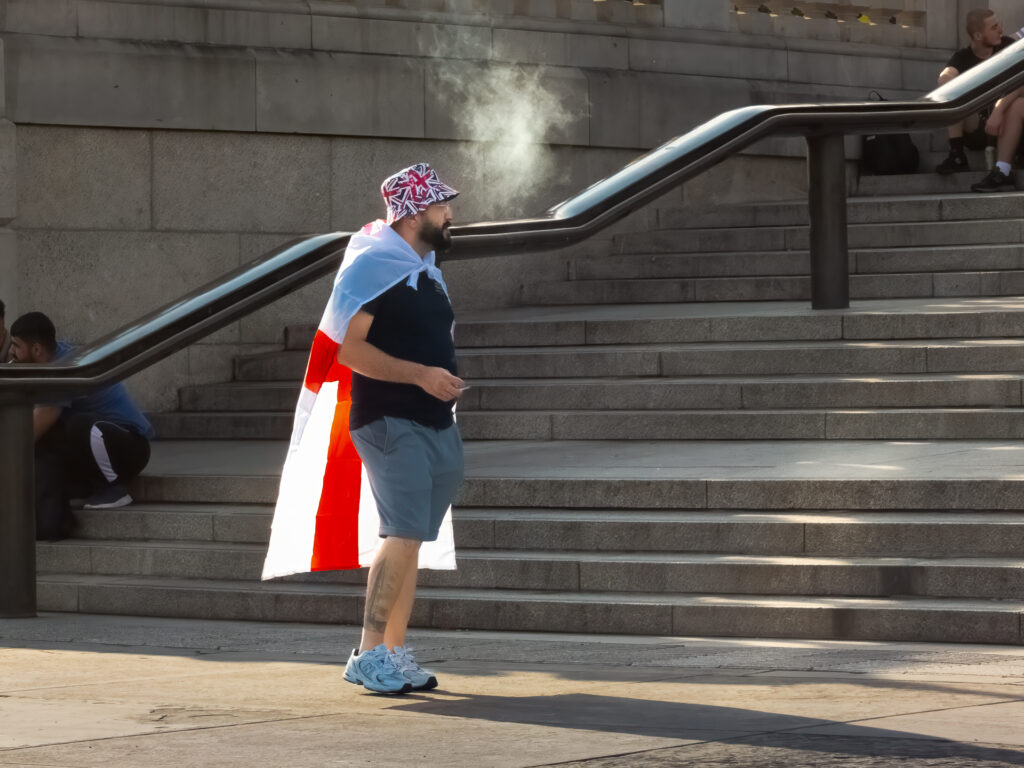
During major football events, Trafalgar Square transforms. Had England won the UEFA Euro 2024 final instead of finishing second, the space might have erupted into an impromptu carnival. Strangers would have come together in triumph, flags waving in a sea of red and white. Even in relative defeat, traces of that energy linger.
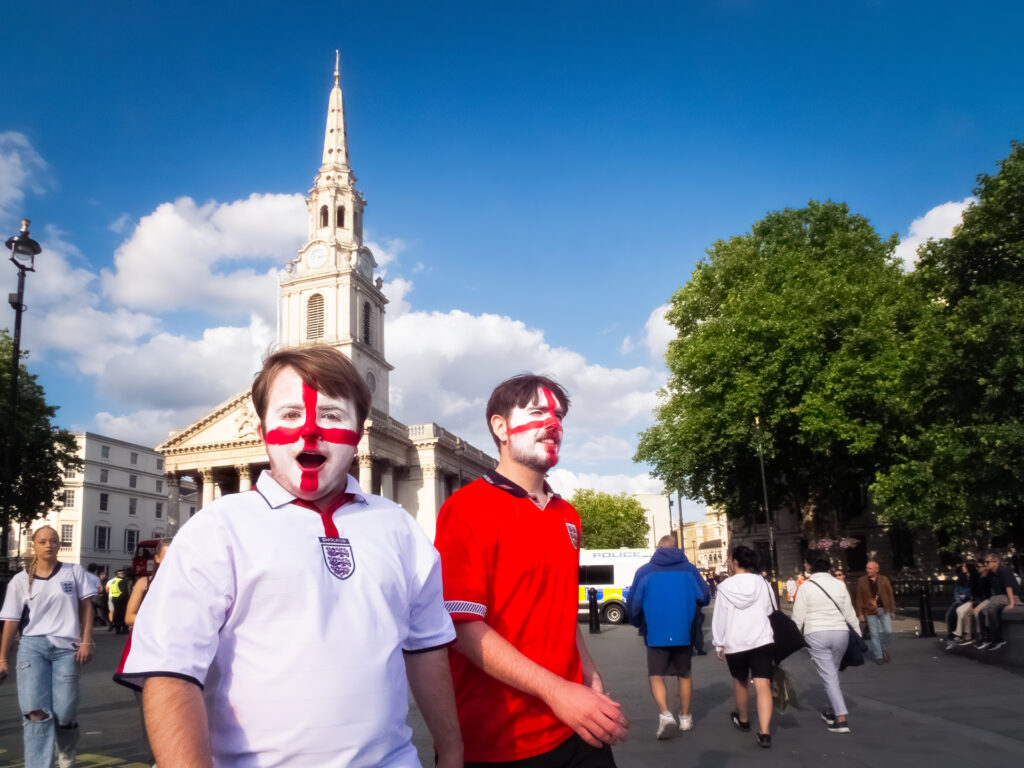
The Changing Square: Sunset and Photography Hotspots
As the sun sets, Trafalgar Square takes on a different character. Golden light reflects off the fountains, the façade of the National Gallery glows, and every silhouette is sharpened against the fading sky.
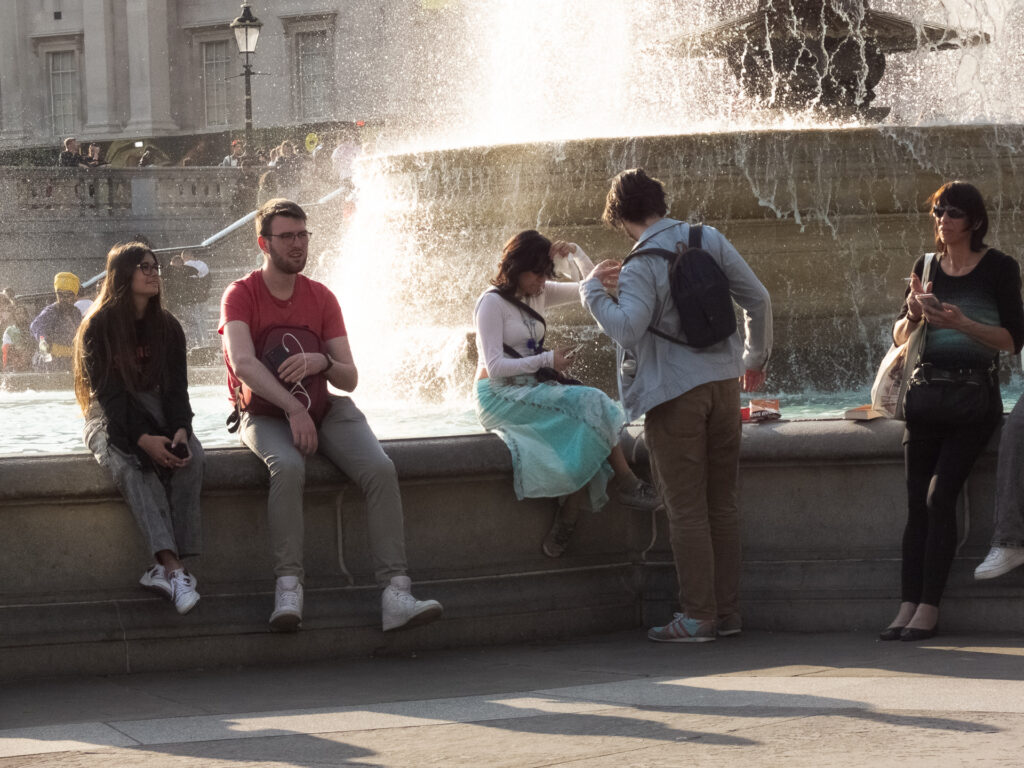
Isolation near the square
A person sits on the steps of St. Martin-in-the-Fields, and he is present yet distant. His book is open, headphones in place, as the city swirls around him. Whether a barrier against the noise or just a quiet pause, he remains still while the world rushes on.
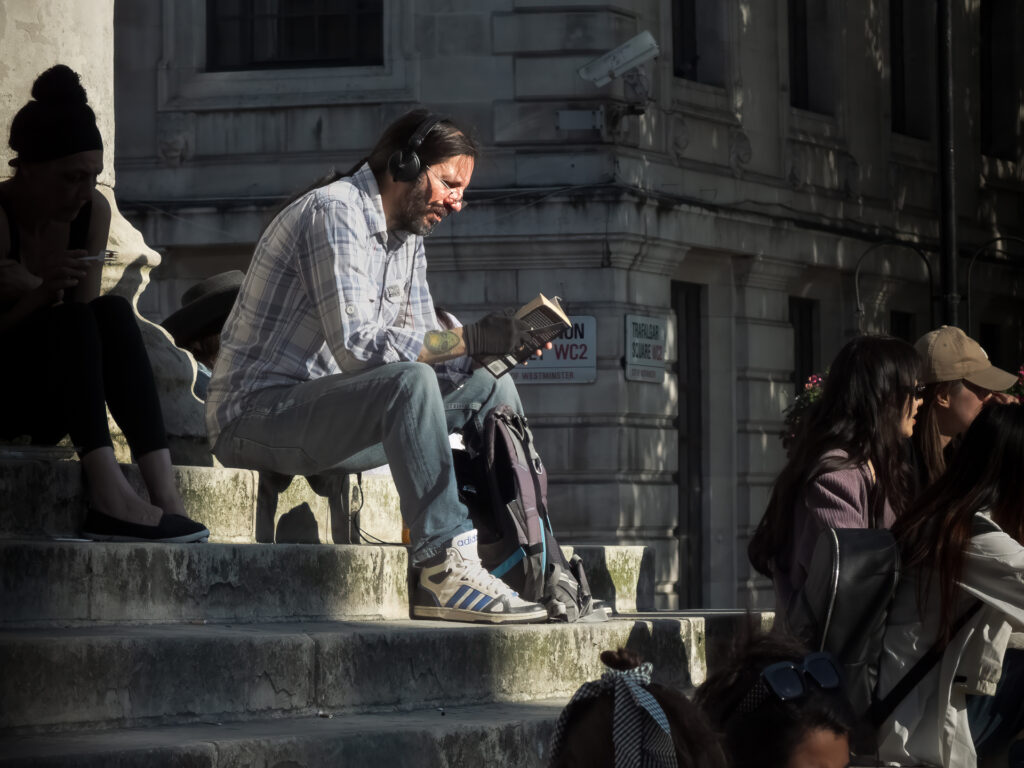

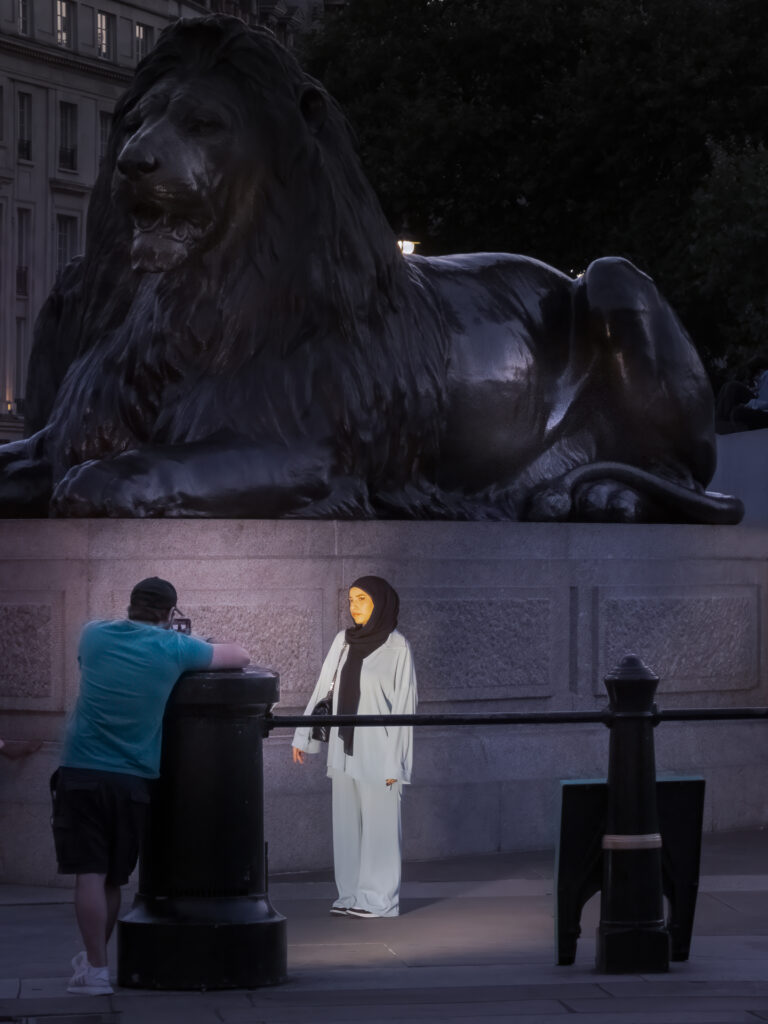
The Luxury of Free Culture: Art for All at the National Gallery and National Portrait Gallery
Unlike their counterparts in some of the global cities that occupy the upper echelons of Mercer’s Cost of Living Index, the National Gallery in London offers something remarkably rare: free access. On most days, you’ll see people queued up outside. Something is striking in such collective patience; even if some people are indifferent to the treasures inside, they are all united in the shared ritual of waiting.
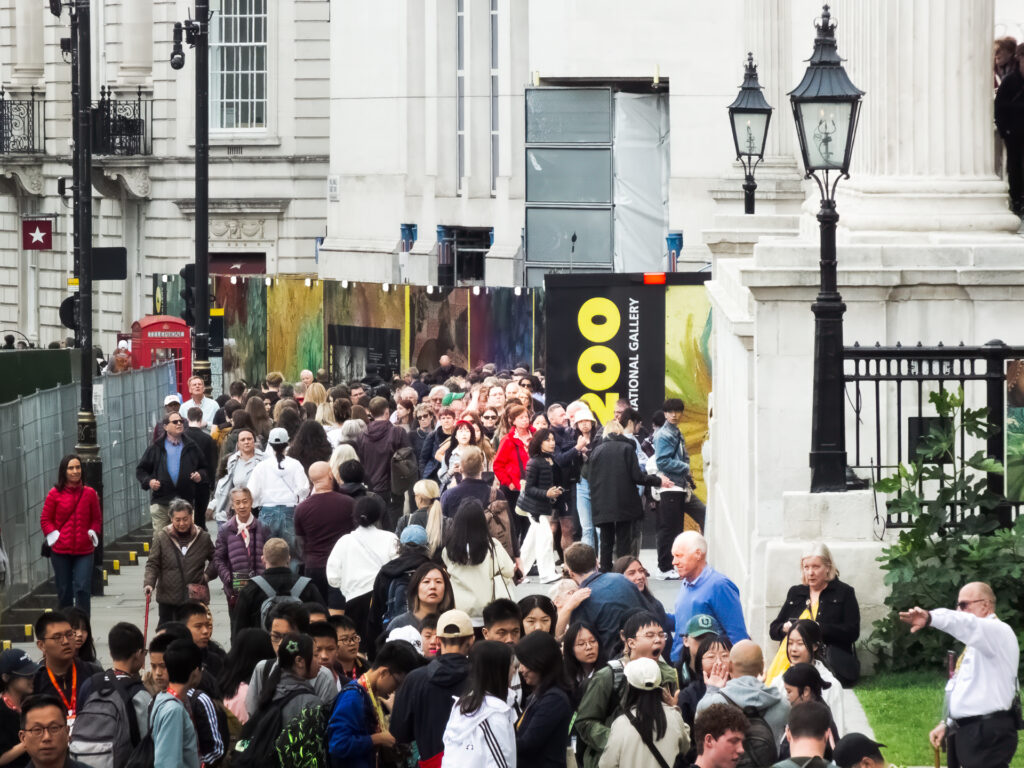
And the most beautiful thing is, that because there is no cost of entry, you do not need to commit to a full visit. If time is short, you can simply step in for a few minutes, take in something extraordinary, and be on your way. With the queues, this might take a little longer, but the possibility remains.
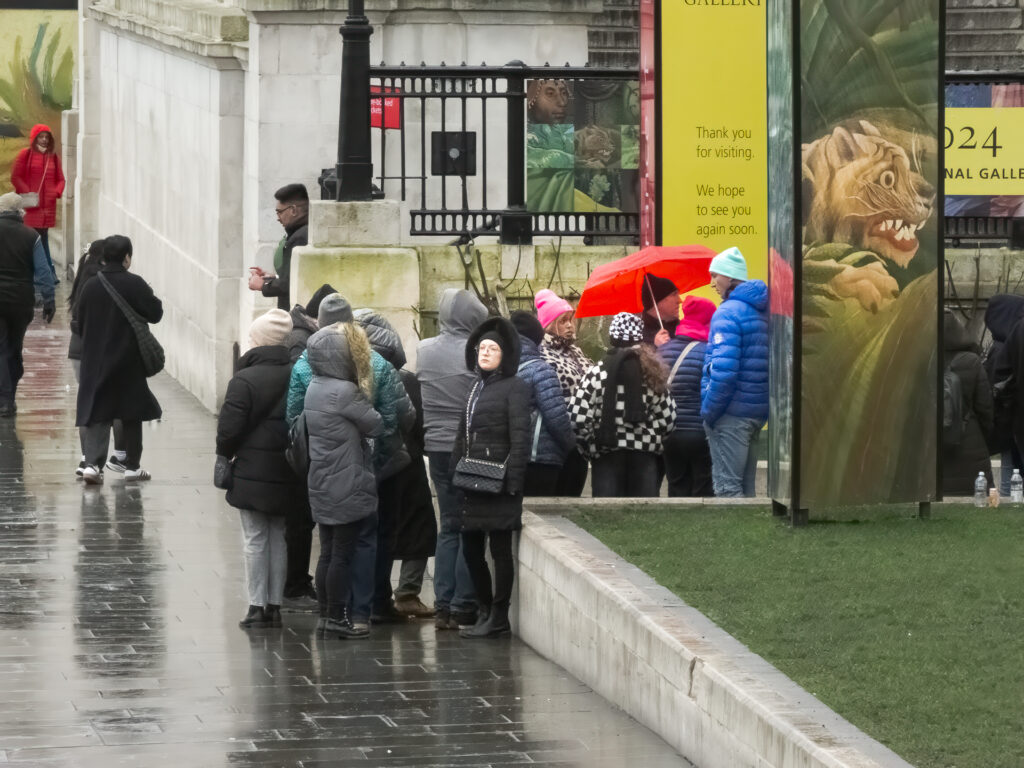
Nearby, the National Portrait Gallery extends the same invitation, offering free access to its collections as well. For all the tourists who might be indifferent, for all those who might just be passing through, the simple fact remains: you can visit, at any moment, without cost, and that, in itself, feels like a quiet miracle in a city so often defined by its expensive tastes.
Small is beautiful? My Fujifilm FinePix HS30EXR.
I took all the photographs in this article with the Fujifilm FinePix HS30 EXR, a camera built around its defining feature: a zoom lens equivalent to 24–720mm in 35mm terms (for the 24x36mm format). The lens achieves its impressive reach thanks to a small 1/2-inch, 16MP CMOS sensor, which keeps the body very compact. Most, though not all, of the pictures in this article were taken at the longer end of the zoom, and mostly in the evenings of sunny days.
The Fujifilm HS30 allowed me to shape my approach to photographing for this project by relying on the reach and compression of the camera’s long lens. I wanted to move away from the trend in urban photography that seems to favour the results achieved by using compact cameras with large sensors and short focal lengths. My intent for this project was not to document the world around me with a wide-angle view. I wanted to extract details from the broader tableau.
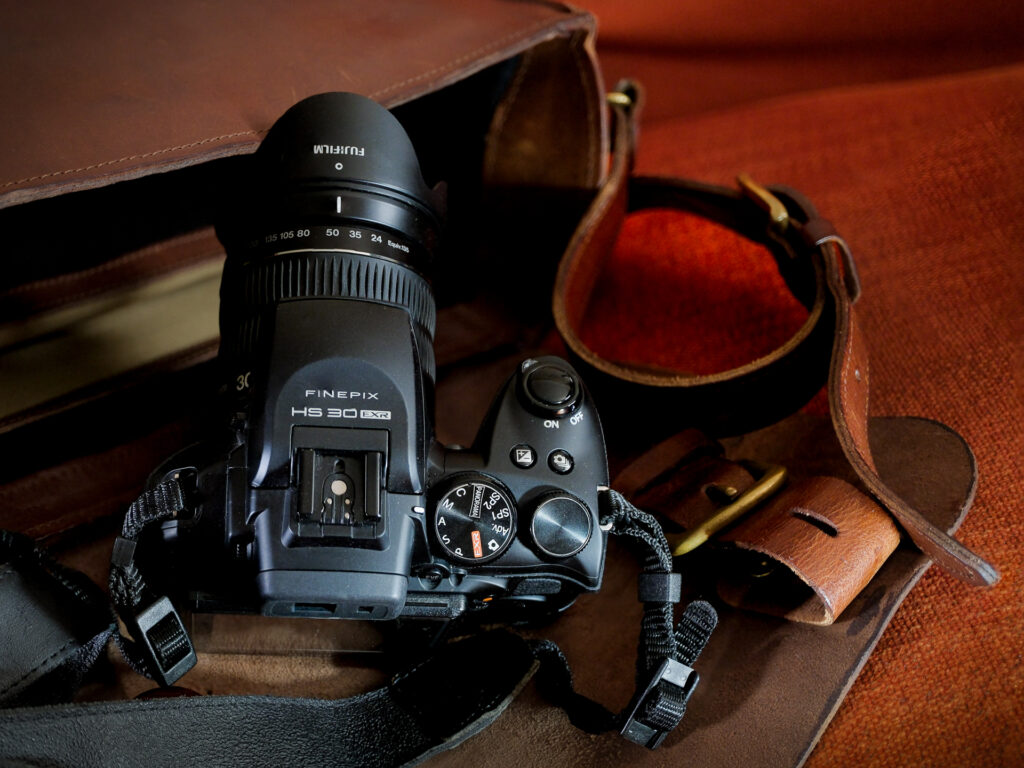
The tools traditionally used for such selective seeing are the long telephoto lenses, the sort of equipment you see on the sidelines of sports or used for the natural world. I could not carry such burdens, but I still wanted their effect. The HS30, with its tiny sensor and powerful zoom, offered me a solution. It gave me the ability to isolate subjects, compress space, and observe from a distance. Of course, this came with some technical trade-offs. Digital noise was ever-present, and the camera, a low-end (mid-range?) consumer model designed to simplify photography, does not really offer direct access to settings, so it does require extra effort to guide it effectively.
Guiding the autofocus, for example, can be frustrating. Moving the focus zone around the frame takes multiple steps, and if the camera sits unused for a while, the button sequence can be easy to forget. The owner’s manual suggests using the focus-and-recompose technique, a method from the early days of autofocus when cameras had a central fixed point for autofocus. While this approach can work in a pinch, it quickly introduces depth of field issues, particularly at long zoom or with close subjects. The fully automatic autofocus selection delivers mixed results. As for completely manual focus, it is there, controlled via a fly-by-wire ring with magnification assistance, but it feels like something you would prefer to ignore.
As a small-sensor camera, it performs best in good light. Above ISO 800, noise becomes very noticeable, and higher ISOs are needed not just in low light situations, but any time faster shutter speeds are required by the long zoom. The multi-zone metering is generally accurate, but tends to underexpose by up to two stops when photographing in the evenings under streetlight, and when it is very sunny, it struggles with high-contrast scenes. The small sensor clips the highlights very quickly.
The camera comes equipped with an optimistic set of now somewhat outdated “smart modes,” bearing names clearly meant to inspire confidence: Anti-Blur, Pro Low Light, and Pro Focus. These were designed as a helping hand, smoothing over the limitations of the small sensor and offering reassurance to those users not familiar with photography. These modes work by blending multiple quick shots, much like today’s smartphones. These modes were supplemented by the EXR (Extended Range) technology on the sensor, a proprietary system that could combine pixels to enhance dynamic range, reduce noise, and improve overall image quality in challenging lighting. However, none of these enhancements affect RAW files, which is an advantage as I wanted to process the files and reduce noise externally. There is also a “Photo Book Assist” feature and a 3D photography mode, though the owner’s manual lists a link to a now-defunct online place for sending those images for printing.
The camera’s build is mostly plastic. The electronic viewfinder has low resolution with visible lines, but I found it very useful. The tilting back screen, by contrast, is of much higher quality. A hot shoe supports Fujifilm TTL flashes, and the camera can use the NP-W126(S) battery that is a common standard across a lot of Fujifilm gear. As for its design, the HS30 may not win over retro enthusiasts. Its mini-DSLR styling does not quite fit today’s trendy vintage aesthetic, and it lacks one of those coveted CCD sensors that some argue mimic film so well.
A Final Thought on Some Free Things to Do
Seasonal displays often brighten the square, showing the city’s diverse celebrations. Depending on when you visit, you might encounter a grand natural Christmas tree, an electric Hanukkah Menorah, or vibrant decorations for Diwali and the Lunar New Year. The square also hosts a variety of events, from screenings of football matches to concerts and political rallies. In the past, the Russian Old New Year has been marked here as well.
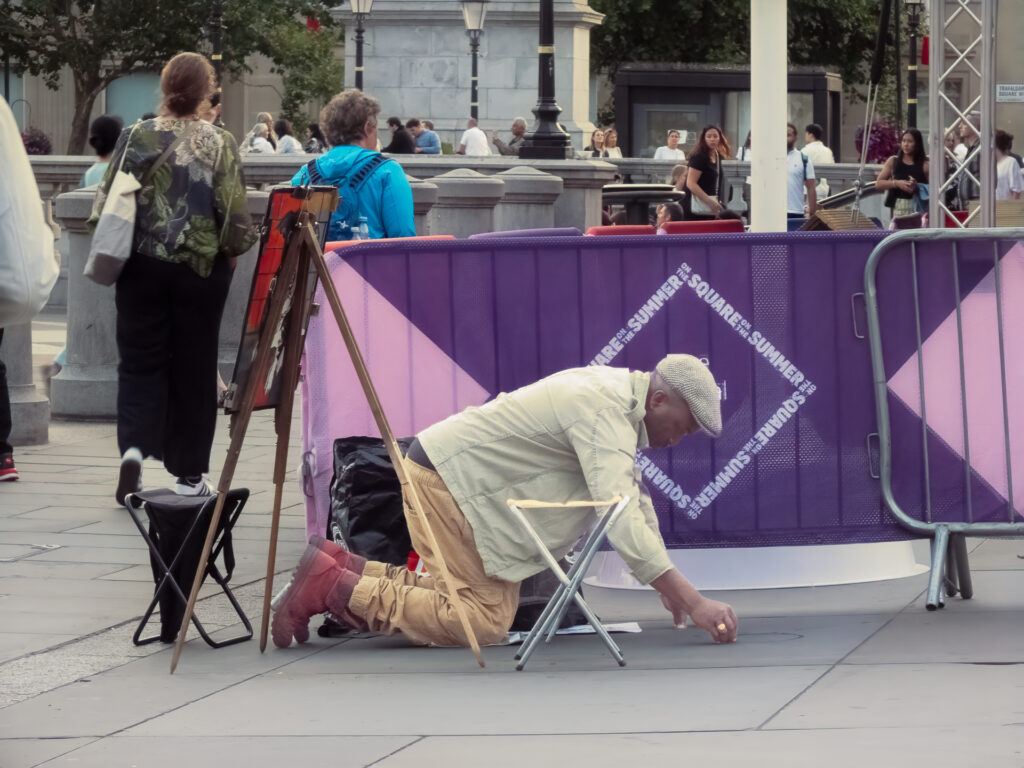
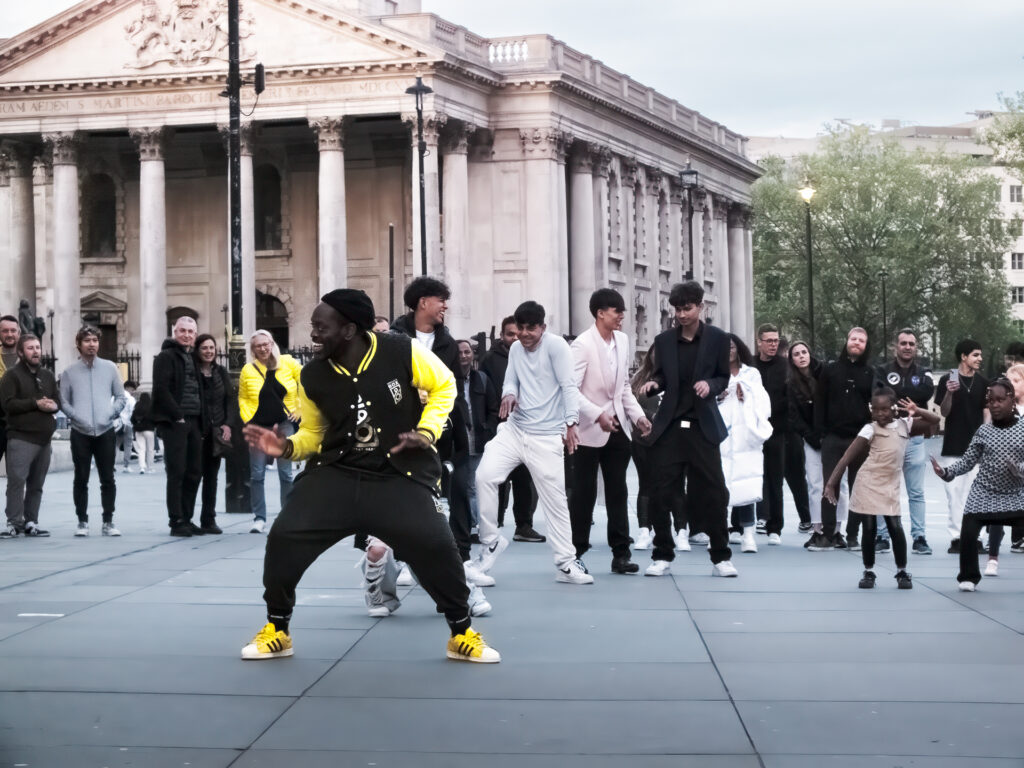
Despite its lively atmosphere, the square often feels more like a thoroughfare than a true destination. It is open, yet somehow uninviting. It is not a place to linger for long. There are few seats, no greenery, and the grand architecture creates a sense of formality rather than comfort. However, just a step away, the National Gallery and National Portrait Gallery remain free to all, thanks to public funding, their own commercial activities, and private donations. You can step inside these galleries at no cost. You could spend hours standing before masterpieces and appreciating that they are accessible to all, rather than locked away in a billionaire’s mansion or hidden in a private collection. If you are after impromptu entertainment, watch as the daring attempt to climb the lion statues, despite the signage, or take a spontaneous dip in the fountains during the warm season. Alternatively, simply pause and take in the sounds of central London.
Share this post:

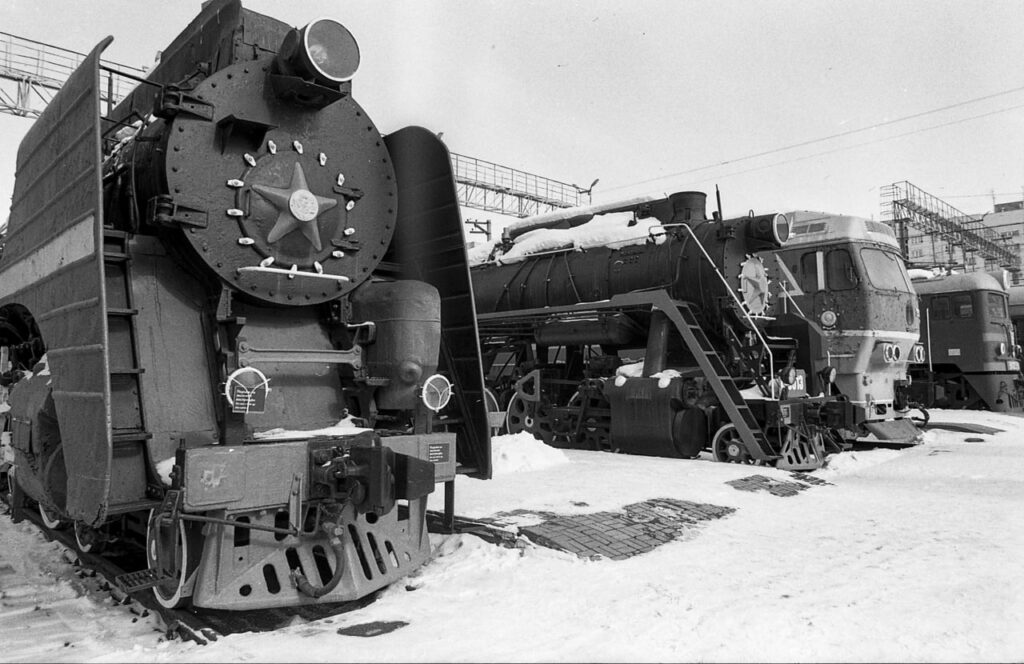


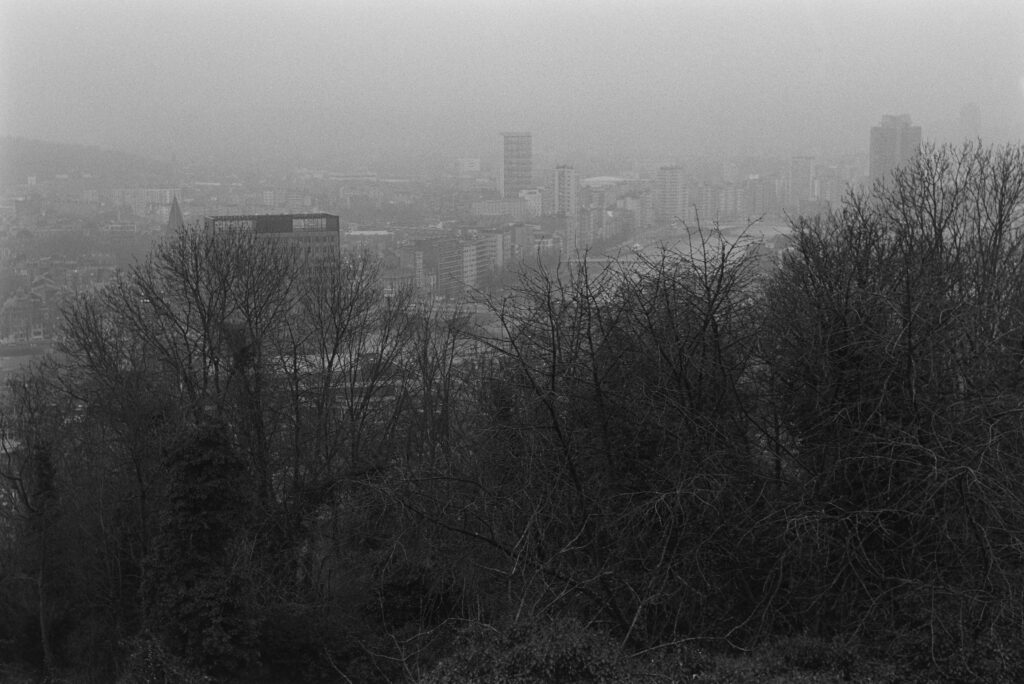

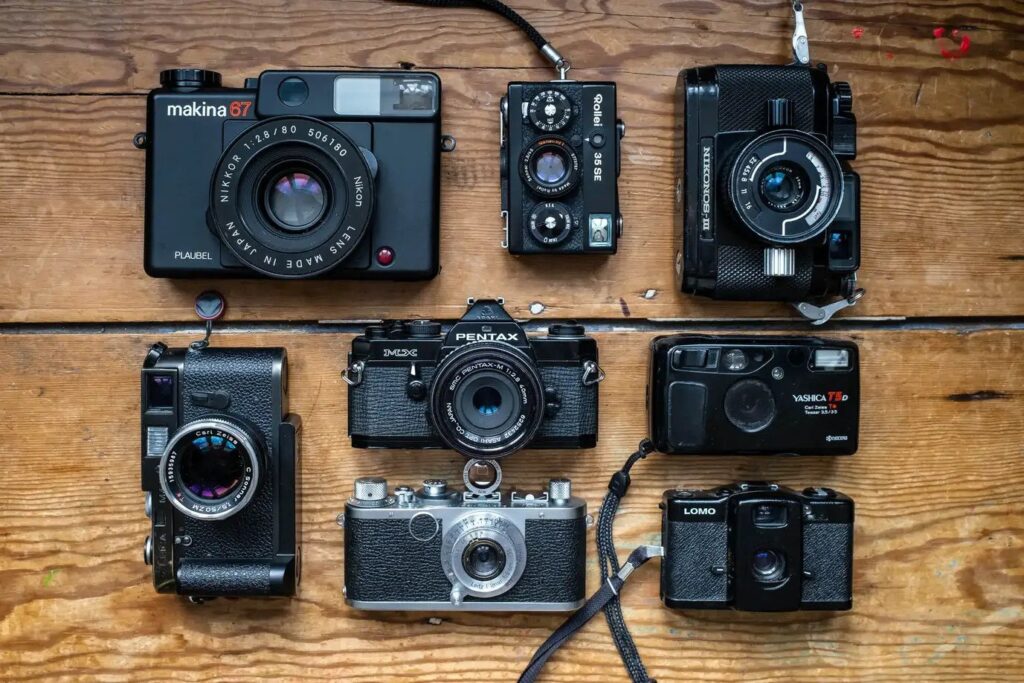
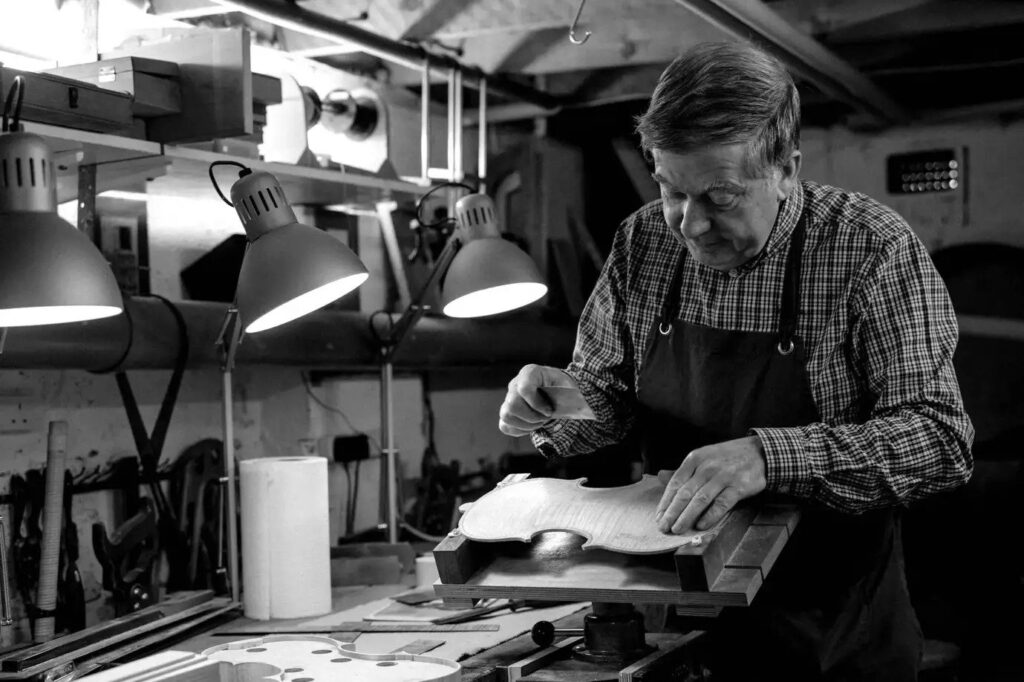
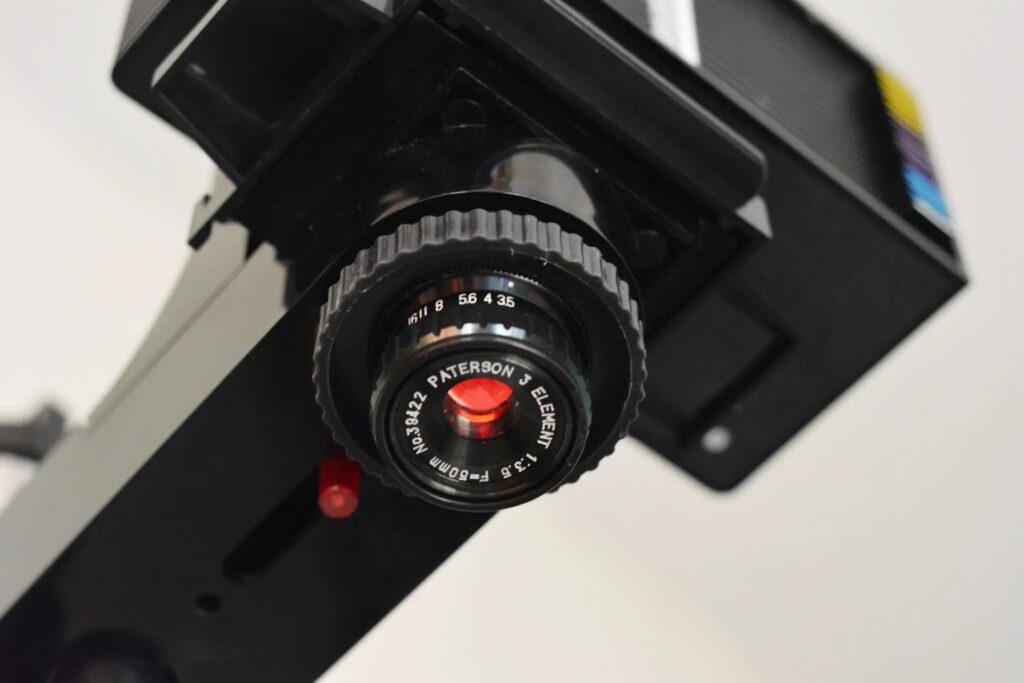
Comments
Michael on Are those Lions Worn Out Yet? London’s No-Cost Adventures
Comment posted: 08/04/2025
Thanks for reminding us of the things that are available to us.
Comment posted: 08/04/2025
David Pauley on Are those Lions Worn Out Yet? London’s No-Cost Adventures
Comment posted: 08/04/2025
Comment posted: 08/04/2025
Comment posted: 08/04/2025
Comment posted: 08/04/2025
Comment posted: 08/04/2025
Comment posted: 08/04/2025
Comment posted: 08/04/2025
Gary Smith on Are those Lions Worn Out Yet? London’s No-Cost Adventures
Comment posted: 08/04/2025
Thanks for sharing!
Comment posted: 08/04/2025
Ibraar Hussain on Are those Lions Worn Out Yet? London’s No-Cost Adventures
Comment posted: 08/04/2025
Comment posted: 08/04/2025
Tony Warren on Are those Lions Worn Out Yet? London’s No-Cost Adventures
Comment posted: 08/04/2025
Comment posted: 08/04/2025
Daniel Castelli on Are those Lions Worn Out Yet? London’s No-Cost Adventures
Comment posted: 09/04/2025
Comment posted: 09/04/2025
Alexander Seidler on Are those Lions Worn Out Yet? London’s No-Cost Adventures
Comment posted: 09/04/2025
Comment posted: 09/04/2025
Thomas Wolstenholme on Are those Lions Worn Out Yet? London’s No-Cost Adventures
Comment posted: 09/04/2025
Comment posted: 09/04/2025